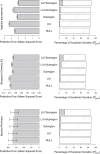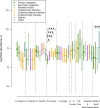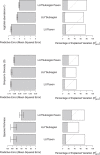Predicting bee community responses to land-use changes: Effects of geographic and taxonomic biases
- PMID: 27509831
- PMCID: PMC4980681
- DOI: 10.1038/srep31153
Predicting bee community responses to land-use changes: Effects of geographic and taxonomic biases
Abstract
Land-use change and intensification threaten bee populations worldwide, imperilling pollination services. Global models are needed to better characterise, project, and mitigate bees' responses to these human impacts. The available data are, however, geographically and taxonomically unrepresentative; most data are from North America and Western Europe, overrepresenting bumblebees and raising concerns that model results may not be generalizable to other regions and taxa. To assess whether the geographic and taxonomic biases of data could undermine effectiveness of models for conservation policy, we have collated from the published literature a global dataset of bee diversity at sites facing land-use change and intensification, and assess whether bee responses to these pressures vary across 11 regions (Western, Northern, Eastern and Southern Europe; North, Central and South America; Australia and New Zealand; South East Asia; Middle and Southern Africa) and between bumblebees and other bees. Our analyses highlight strong regionally-based responses of total abundance, species richness and Simpson's diversity to land use, caused by variation in the sensitivity of species and potentially in the nature of threats. These results suggest that global extrapolation of models based on geographically and taxonomically restricted data may underestimate the true uncertainty, increasing the risk of ecological surprises.
Figures



References
-
- Garibaldi L. A. et al.. Services from Plant - Pollinator interactions in the Neotropics. In Rapidel B., DeClerck F., Le Coq J. & Beer J. (eds.) Ecosystem services from agriculture and agroforestry: measurement and payment, 119–139 (Earthscan, London, UK, 2011).
-
- Food and Agriculture Organization of the United Nations. Pollination of cultivated plants in the Tropics, Issue 118 (Food & Agriculture Org., 1995).
-
- Kevan P. G. & Baker H. G. Insects as flower visitors and pollinators. Annual Review of Entomology 28, 407–453 (1983).
-
- Potts S. G. et al.. Global pollinator declines: Trends, impacts and drivers. Trends in Ecology & Evolution 25, 345–353 (2010). - PubMed
-
- Winfree R., Aguilar R., Vázquez D. P., Lebuhn G. & Aizen M. A. A meta-analysis of bees’ responses to anthropogenic disturbance. Ecology 90, 2068–2076 (2009). - PubMed
Publication types
MeSH terms
Grants and funding
LinkOut - more resources
Full Text Sources
Other Literature Sources

